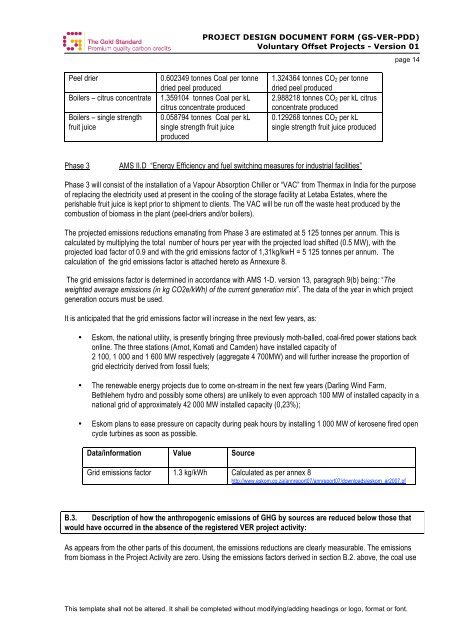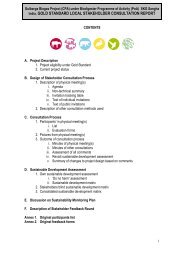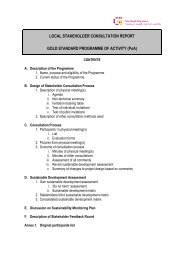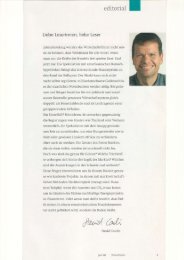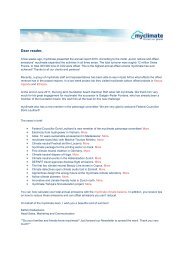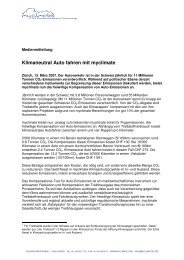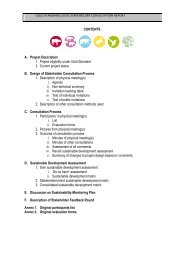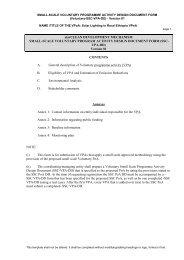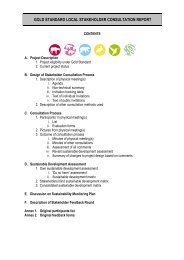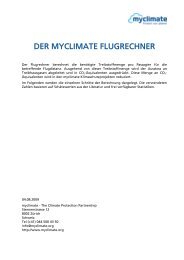Letaba Biomass to Energy PDD - MyClimate
Letaba Biomass to Energy PDD - MyClimate
Letaba Biomass to Energy PDD - MyClimate
You also want an ePaper? Increase the reach of your titles
YUMPU automatically turns print PDFs into web optimized ePapers that Google loves.
Peel drier 0.602349 <strong>to</strong>nnes Coal per <strong>to</strong>nne<br />
dried peel produced<br />
Boilers – citrus concentrate 1.359104 <strong>to</strong>nnes Coal per kL<br />
citrus concentrate produced<br />
Boilers – single strength 0.058794 <strong>to</strong>nnes Coal per kL<br />
fruit juice<br />
single strength fruit juice<br />
produced<br />
PROJECT DESIGN DOCUMENT FORM (GS-VER-<strong>PDD</strong>)<br />
Voluntary Offset Projects - Version 01<br />
1.324364 <strong>to</strong>nnes CO2 per <strong>to</strong>nne<br />
dried peel produced<br />
2.988218 <strong>to</strong>nnes CO2 per kL citrus<br />
concentrate produced<br />
0.129268 <strong>to</strong>nnes CO2 per kL<br />
single strength fruit juice produced<br />
Phase 3 AMS II.D “<strong>Energy</strong> Efficiency and fuel switching measures for industrial facilities”<br />
This template shall not be altered. It shall be completed without modifying/adding headings or logo, format or font.<br />
page 14<br />
Phase 3 will consist of the installation of a Vapour Absorption Chiller or “VAC” from Thermax in India for the purpose<br />
of replacing the electricity used at present in the cooling of the s<strong>to</strong>rage facility at <strong>Letaba</strong> Estates, where the<br />
perishable fruit juice is kept prior <strong>to</strong> shipment <strong>to</strong> clients. The VAC will be run off the waste heat produced by the<br />
combustion of biomass in the plant (peel-driers and/or boilers).<br />
The projected emissions reductions emanating from Phase 3 are estimated at 5 125 <strong>to</strong>nnes per annum. This is<br />
calculated by multiplying the <strong>to</strong>tal number of hours per year with the projected load shifted (0.5 MW), with the<br />
projected load fac<strong>to</strong>r of 0.9 and with the grid emissions fac<strong>to</strong>r of 1,31kg/kwH = 5 125 <strong>to</strong>nnes per annum. The<br />
calculation of the grid emissions fac<strong>to</strong>r is attached here<strong>to</strong> as Annexure 8.<br />
The grid emissions fac<strong>to</strong>r is determined in accordance with AMS 1-D. version 13, paragraph 9(b) being: “The<br />
weighted average emissions (in kg CO2e/kWh) of the current generation mix”. The data of the year in which project<br />
generation occurs must be used.<br />
It is anticipated that the grid emissions fac<strong>to</strong>r will increase in the next few years, as:<br />
• Eskom, the national utility, is presently bringing three previously moth-balled, coal-fired power stations back<br />
online. The three stations (Arnot, Komati and Camden) have installed capacity of<br />
2 100, 1 000 and 1 600 MW respectively (aggregate 4 700MW) and will further increase the proportion of<br />
grid electricity derived from fossil fuels;<br />
• The renewable energy projects due <strong>to</strong> come on-stream in the next few years (Darling Wind Farm,<br />
Bethlehem hydro and possibly some others) are unlikely <strong>to</strong> even approach 100 MW of installed capacity in a<br />
national grid of approximately 42 000 MW installed capacity (0,23%);<br />
• Eskom plans <strong>to</strong> ease pressure on capacity during peak hours by installing 1 000 MW of kerosene fired open<br />
cycle turbines as soon as possible.<br />
Data/information<br />
Value Source<br />
Grid emissions fac<strong>to</strong>r 1.3 kg/kWh Calculated as per annex 8<br />
http://www.eskom.co.za/annreport07/annreport07/downloads/eskom_ar2007.pf<br />
B.3. Description of how the anthropogenic emissions of GHG by sources are reduced below those that<br />
would have occurred in the absence of the registered VER project activity:<br />
As appears from the other parts of this document, the emissions reductions are clearly measurable. The emissions<br />
from biomass in the Project Activity are zero. Using the emissions fac<strong>to</strong>rs derived in section B.2. above, the coal use


